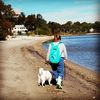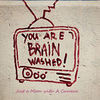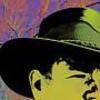Photographing fast moving indoor events with low light
Oct 31, 2011 17:08:38 #
Useing lens for shooting fast moving basketball games what appropriate lens would be used for freezing action with existing light no flash no tripod heres a pic how to correct this
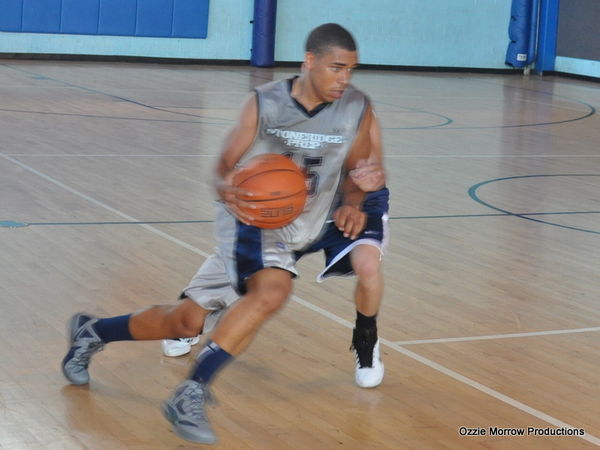
Oct 31, 2011 18:21:18 #
One way is to get a 1.4 lens. Nikon makes a relatively inexpensive one in 50mm, and the other manufacturers probably also do. With that, and a raised ISO, you should be able to get some nice sharp images in gymnasium lighting.
Oct 31, 2011 18:53:07 #
Lets say I have a 50mm at 1.4 lens What ISO would I use and how does it sharpen the picture I usually have my ISO on automatic is that bad?
Oct 31, 2011 21:03:03 #
The 1.4 number is the most open (widest aperture) the lens will operate at. You can close it down when you have more light. Most DSLRs operate at an ISO (film or sensor light sensitivity) of 200 to 1600 and some newer ones even higher. A larger number increases the sensitivity of the sensor (I think you can still buy film in 100-400 and 1600 sensitivities and maybe in 50). If you have really low light, you can set your aperture at 1.4 or 2.8 and set your ISO at 800 and should be surprised at how much motion you can stop with a faster shutter speed. The "grain" of your image will increase with higher ISO settings, but should be negligible up to 800. Play with it. If you have other lenses, just open them up to the largest aperture (lowest number written on the lens) available and boost the ISO. Play with it. Good luck.
Nov 1, 2011 07:19:40 #
ahzwizerd2 wrote:
Lets say I have a 50mm at 1.4 lens What ISO would I use and how does it sharpen the picture I usually have my ISO on automatic is that bad?
The ISO setting itself does not sharpen the image. It is merely a setting controlling how sensitive your digital sensor is. It is called ISO because the different settings are equal to ISO ratings of film which of course is how light sensitive the film is. The higher the ISO, the more sensitive to light the film or digital sensor is. This means the higher the ISO setting is the faster your shutter speed can be. This is how it will help stop motion in your photo.
Ex: If you were shooting at f2.8 and 1/125 @400 ISO you could raise the ISO to 800 and increase your shutterspeed to 1/250.
My estimation of your required exposure would be ISO 800, f2.0 @ 1/250. Different gyms are lit differently and there is usually more light around the basket. If this is not enough, I would go to ISO 1600 before I would slow the shutter.
At 1/250 you should be able to get some usable photos. It wont stop all of the blur. One thing to keep in mind is the closer the motion is to the lens, the more blur there will be. Try to keep the action a little farther away and it will help. This also helps to keep you from cutting heads or feet off. You can do a little cropping later.
Nov 1, 2011 07:42:41 #
Thanks for that advise. I recently learned that in a class I took and practiced several times at my sons baseball games that are late evening and it worked great..I captured the baseball coming to home plate and you can actually see the threads on the ball it is so sharp. Now that basketball season starts this week I was hoping to do the same in the gym...your pointers sound excellent
Nov 1, 2011 09:30:13 #
I think for Pics of action sports a 50mm is not going to be long enough but if thats all the cash in the cookie jar. Faster lens and higer iso will help with light and faster shutter will help with blur but hurt with available light.
Nov 1, 2011 10:12:10 #
I agree a 50mm isn't going to be long enough to get great shots, especially coupled with a crop sensor (which I am assuming you have).
Let's start backward:
What Camera are you using?
What lenses do you have in your bag?
Let's start backward:
What Camera are you using?
What lenses do you have in your bag?
Nov 1, 2011 11:33:21 #
Without knowing the settings of the example image, it's difficult to give out accurate recommendations..
An indoor sports shooter would love a 70-200 f2.8 lens though..
An indoor sports shooter would love a 70-200 f2.8 lens though..
Nov 1, 2011 11:39:23 #
I shoot a lot of indoor sports. It's definitely a challenge.
I'd say get your ISO up as high as it will go. That's the first thing.
Next, take some test shots and get an idea of what shutter speed you can use to stop the action reasonably. I'd then either use manual mode or shutter priority mode, and set the shutter speed to that optimal setting. Lens (aperture) wide open, of course.
And if the light is horrible, you might just have to underexpose a little bit and then up the exposure when you get home in post processing. Shooting in RAW will give you more to work with in post processing, and so the quality will be better than if you shot in jpg.
And lastly, if you can, I would get their early, and use an Expocard or Expodisc and take a reference shot through it, shooting directly into one of the overhead light sources. Use this shot as your custom white balance. The colors will come out a lot better doing this.
If you don't feel comfortable doing a custom white balance, then leave experiment and see if settiing the white balance to tungsten or florescent, depending on the lights they use, and see if you like those colors better than what Auto white balance gives.
And of course, you can always leave it on auto white balance and correct color in post processing (if you're shooting in RAW).
I'd say get your ISO up as high as it will go. That's the first thing.
Next, take some test shots and get an idea of what shutter speed you can use to stop the action reasonably. I'd then either use manual mode or shutter priority mode, and set the shutter speed to that optimal setting. Lens (aperture) wide open, of course.
And if the light is horrible, you might just have to underexpose a little bit and then up the exposure when you get home in post processing. Shooting in RAW will give you more to work with in post processing, and so the quality will be better than if you shot in jpg.
And lastly, if you can, I would get their early, and use an Expocard or Expodisc and take a reference shot through it, shooting directly into one of the overhead light sources. Use this shot as your custom white balance. The colors will come out a lot better doing this.
If you don't feel comfortable doing a custom white balance, then leave experiment and see if settiing the white balance to tungsten or florescent, depending on the lights they use, and see if you like those colors better than what Auto white balance gives.
And of course, you can always leave it on auto white balance and correct color in post processing (if you're shooting in RAW).
Nov 1, 2011 13:49:27 #
ahzwizerd2, I deduce from your picture with an external flash unit that you are shooting with an SLR. I shoot basketball games with Canon SLR, usually the 28-300 mm F3.5-5.6 IS. It is an L lens. With the newer SLRs, like the 7D capable of good performance at high ISO, the lack of F2.8 aperture is no problem. I suggest shooting at 1/320 shutter speed. If the practice picture is not a direct hit, adjust the exposure value first, then the ISO. If you drop the shutter speed to 1/250 fast moving hands will be blurred. If you go higher than 1/320 make sure that the ISO and the exposure compensation dial in a good exposure. I present on example of the results.
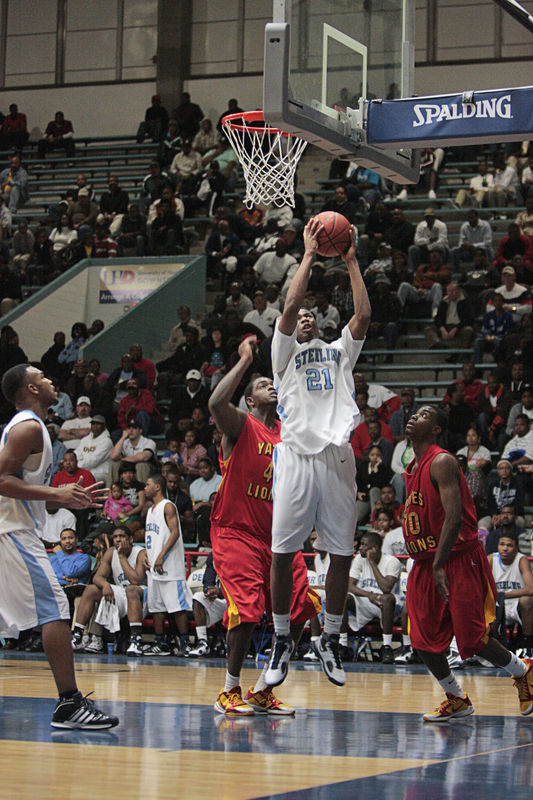
Nov 1, 2011 14:12:31 #
I have taken many a picture in a gym with my D60 and 55-300mm with good results. Ultimately in the end a f2.8 lens is the way to go. I have to shoot in ISO 3200 with some grain.
Nov 1, 2011 14:31:44 #
One tip on white balance. You'll need to verify this in your case, but I believe that any NCAA arenas where they might be televised (ever), have a requirement that the lights have a color temperature of 4900. So, for the most part, most college gyms will have lights like this just in case.
As a result, you might be able to just dial in the Kelvin color temperature for your white balance; if this is true in the case of the gym where you're photographing. It's worth a try to at least get there early and test and see.
As a result, you might be able to just dial in the Kelvin color temperature for your white balance; if this is true in the case of the gym where you're photographing. It's worth a try to at least get there early and test and see.
Nov 1, 2011 14:36:14 #
ahzwizerd2 wrote:
Useing lens for shooting fast moving basketball games what appropriate lens would be used for freezing action with existing light no flash no tripod heres a pic how to correct this
Just a different take: The advice you've received is good for stopping the action. However, I've seen great action shots with motion blur, particularly if you pan with the participant and let the background blur with streaks in the direction of the pan.
Joe
Nov 1, 2011 14:39:08 #
les_stockton wrote:
One tip on white balance. You'll need to verify t... (show quote)
Maybe I recalled that wrong. I just read an NCAA document that says the color temperature must be 3200.
http://www.ncaa.org/wps/portal/ncaahome?WCM_GLOBAL_CONTEXT=/ncaa/ncaa/sports+and+championship/general+information/championships+administration/di+w+soccer+ss+bid+specs
It would be worth testing out.
If you want to reply, then register here. Registration is free and your account is created instantly, so you can post right away.



